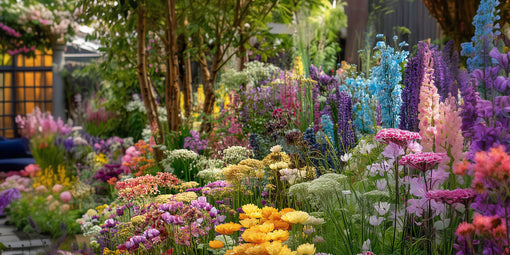
- Article published at:
Drawer menu

Queen Anne’s Lace is a flower known by many different names. Some of them being Ammi Majus, Bishops Lace, Wild Carrot and Bird’s Nest. But in fact, all of them, except Ammi Majus are different names given to the same flower.
In this blog post we’ll dig deeper in the history of the Queen Anne’s Lace, its flower meaning, and show you how you can grow your very own delicate blooms.
Most people, even us florists, usually use the name Ammi when referring to any of these different names as previously mentioned. But in reality, Ammi Majus is said to be one of Queen Anne’s Lace relatives.
Both Queen Anne’s Lace and Ammi Majus belong to the Daucus carota family. However expert gardeners and even florists recognize Queen Anne’s Lace as one and only one distinct plant, even though the Ammi Majus is a very suitable alternative. Scroll down to find out more.

Originating from Europe, the species is commonly found in Michigan, Ohio, West Virginia as well as Minnesota and Illinois, where it’s considered to be a noxious weed. Queen Anne’s Lace is a very hardy plant that thrive in various climate conditions but prefer a dry environment.
This plant has delicate and pristine white flowers and is in bloom from June to September. Its flowers grow in flat clusters knows as umbels. The word umbels come from the plants small white flower heads that faces upwards on resembles the shape of an umbrella, therefore the name ‘umbel’.
Ammi Majus, also called ‘false Queen Anne’s Lace’, belongs to the same family as the True Queen Anne’s Lace, the Apiaceae family. It looks very similar to the true Queen Anne’s Lace and is therefore often mistaken by it. However, Ammi Majus has slightly thicker stems.
Ammi Majus originated from the Nile River Valley thousands of years ago and Egyptians used the juice of the flower to ‘treat’ people with vitiligo. Modern research has sadly shown that not only can the condition be worsened by the excess of photosynthesizing agents in the flower, but also cause severe skin inflammation.
This type is also known as ‘Wild Beaked Parsley’, ‘Cow Parsley’, ‘Keck’ or ‘Wild Chervil’ and looks very similar to Queen Anne’s Lace. It’s native to Europe and Asia, although this plant is spotted in other parts of the world. The cow parsley usually blooms throughout spring and early summer and quite aggressively as well we might add.

Queen Anne’s Lace has delicate lace-like flowers and is associated with beauty. The flower is sometimes referred to as ‘bishops flower’ and therefore it has become to symbolise sanctuary, safety and refuge.
It’s believed that the flower got its name from when Queen Anne II was tatting white lace, she pricked her finger with the tatting needle, and it caused a drop of blood to fall on the lace.
The Queen Anne’s Lace thrive best in clay and loam mixed soil that has a slightly acidic pH level. It prefers full to semi-full sun and moderate to low humidity.
The plant can be difficult to get rid of once planted so be sure you are happy with the spot you choose before deciding to plant.

Our pretty Saga features delicate British grown Ammi Majus flowers and available to order for next day delivery UK wide. View our whole collection of British grown flowers here.